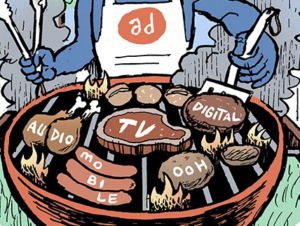“On TV And Video” is a column exploring opportunities and challenges in advanced TV and video.
Today’s column is written by Lindsey Harju, co-founder at Blinc Digital Group.
Time-sensitive marketing triggers are nothing new. Ever moved and received a mailbox full of offers?
In the last few months, my business partner and I have sold a home, moved out of state, purchased two new vehicles and made it through the first trimester of a new pregnancy. With the multitude of signals and indicators unleashed by our search and browsing behavior, you would think we would be inundated with highly relevant ads across our media experiences – especially TV.
Alas, nothing.
What a big opportunity for marketers. TV and triggers are the perfect marketing marriage, as large purchase decisions often carry a great deal of emotion with them. And what better channel to convey an emotional message than TV?
I understand the reality of how campaign launch timelines differ between TV and digital. When a consumer shows an intent signal, that data first cycles through a data provider or aggregator and then through to the marketer or even directly to a media-buying mechanism. In digital, this process could take moments to hours or possibly days, based on the systems.
In TV, however, it may take weeks or months for many techniques to reflect a consumer signal in the media targeting or personalization of a buy. By that point, I have purchased the vehicle, selected my mortgage and completed my baby registry.
Due to timeline misalignment between consumer buying patterns and data activation on TV, I believe TV marketers had essentially given up any dreams of applying trigger or time-sensitive data segments. But TV is different now – it’s a cross-screen experience with loads of identifiers and automated systems powering buys – and I think it’s ready.
But to apply time sensitive data to TV, marketers must consider which tactics they can use to activate intent signals quickly and the related consumer sales cycles.
Connected TV
For marketers seeking that “living room” brand experience, many digital tactics can be applied via Connected TV. Behind online video, it’s the fastest reacting TV tactic though it has its own complexities. Many online triggers are initiated at the individual level, while a CTV device applies to the household level. Marketers need the right vendors in place to quickly translate those identifiers and stay within a meaningful period after the original consumer signal.
Addressable TV
Brands with slightly longer sales cycles may be able to include addressable TV in their campaigns. For example, an insurance provider would likely want to reach pre-movers, which may not be possible. But grocery stores and pet services could still benefit from reaching someone who has already moved in but still has a few boxes left to unpack.
With a delay between data submission and live media of three to four weeks, brands must carefully consider their sales cycle to ensure their testing of triggers in addressable TV isn’t full of data decay and media waste.
Practical triggers
Certain triggers are impossible for traditional TV buyers until targeting and buying systems can operate in near real time. If I can research a product and reach conclusions within an hour, it’s unlikely that I will see a 30-second spot before my purchase.
For larger considered purchases, like a vehicle, this is absolutely possible. The average research period for new vehicle purchases is one to three months. Auto makers have only a few weeks to get their models in front of prospective buyers to be included in evaluation. In the couple months I actively researched minivans, I noticed more sedan and pickup truck ads than ever. Where were the personalized experiences that played up safety ratings and copious amounts of cupholders?
For CTV, a couple of weeks is absolutely practical, and not just for auto marketers. The same can be said for new movers, new parents and in-market targets for large considered purchases. Smaller repeatable purchases are more likely to fall within other intelligent targeting mechanisms that are not as time sensitive.
Reducing delays
To ensure testing is as effective as possible, evaluate every point in the daisy chain that occurs between the consumer and when the media shows up on the screen.
The source of data collection: Ask about the refresh cycles, exclusion of older consumer signals and any delays that occur between the original consumer action and their systems.
The points of passage: How much time passes between when the data is translated from the original collector and destinations involved with activation? Is there a larger timeline for new projects but an opportunity for real-time communication with the proper setup?
The media buying or personalization system: How long is the delay between when the data is received and when it can be implemented as part of the campaign?
If any player in the process is adding delays significant enough to make the test ineffective before you even launch, I would encourage buyers to evaluate other vendors. In an age when everyone claims “real-time” capabilities, there is little excuse for massive delays in transmission.
That is my hope for TV-loving data professionals and data-loving TV buyers. As an industry we’ve proven that data can be applied successfully to TV buys. What was formerly considered a branding-only channel can now be used by direct response brands. Now let’s stretch our capabilities further by adding some speed.
Follow AdExchanger (@adexchanger) on Twitter.













